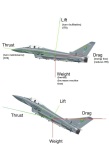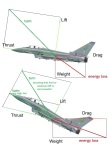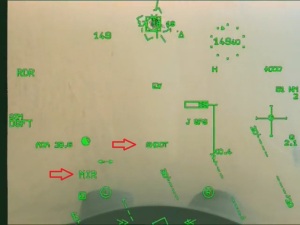With introduction of thrust-vectoring F-22 and Su-35, many claims have appeared, such as that thrust vectoring aircraft are most maneuverable in the world and that addition of thrust vectoring alone guarantees that fighter in question will be unrivalled in maneuverability, excepting of course other thrust vectoring aircraft. These claims hold that addition of thrust vectoring by itself is enough to turn otherwise-sluggish fighter aircraft into supreme air-to-air machine. Things are more complex than that, however; effectiveness of thrust vectoring depends on aircraft’s aerodynamic configuration, speed and altitude.
To discuss thrust vectoring, we must first know how non-TVC aircraft behave. Major parameters that impact aircraft’s performance are:
- weight
- lift, which can be approximated through wing loading
- excess thrust, determined by thrust to weight ratio
- drag
One of advantages of thrust vectoring is allowing aircraft to enter and recover from a controlled flat spin, yawing aircraft without worrying about rudder, which looses effectiveness at high angles of attack. However, aircraft using close coupled canards instead of thrust vectoring have also demonstrated flat spin recovery capability, example being Saab Gripen. But while thrust vectoring reduces drag during level flight, thus increasing the range, close-coupled canards add drag and decrease lift unless aircraft is turning, thus improving the range.
But to see what impact thrust vectoring has on combat performance, we have to take a look at parameters I have defined above. Mass of aircraft determines inertia – thus, heavier the aircraft is, longer it takes to switch from one maneuver to another quickly. This results in slower transients, making it harder for pilot to get inside opponent’s OODA loop – in fact, mass is defined as a quantitative measure of an object’s resistance to acceleration (to clear common mistake in terminology, acceleration can be in any direction – in fact, what is commonly called “deceleration” is mathematically defined as “acceleration”). But to actually turn, aircraft relies on lift. Lift is what allows aircraft to remain in the air, and when turning, aircraft uses control surfaces to change direction in which lift is acting, resulting in aircraft turning around imaginary point. It can be approximated by wing loading. But turning leads to increase in angle between air flow around the aircraft and the aircraft itself (this angle is called Angle of Attack), which results in increased drag. Increasing drag means that aircraft looses energy faster, and once fighter’s level of energy decays below that of his opponent, he is fighting at disadvantage. Loss in energy can be mitigated by excess thrust, which can also be used (usually in combination with gravity, aka downwards flight) to recover lost energy. All of this leads to expression “out of ideas, energy and altitude”, which basically means “I’m in trouble and have no way out”. Nose pointing allows aircraft to gain a shot at opponent with gun, and was crucial for gaining a shot at opponent with missiles before advent of High Off Bore capability, which shifted requirements more in direction of ability to sustain maneuvers at or near corner speed (minimum speed at which aircraft can achieve maximum g loading; it is usually around M 0,6 – 0,9). It must be noted that, while lift and excess thrust of aircraft can be approximated by wing loading and thrust to weight ratio, heavier aircraft will require higher thrust to weight and lift to weight ratios to achieve same turn rates as lighter aircraft.
Thrust vectoring, as its name says, results in shifting of the thrust. Due to modern fighter aircraft’s center of gravity and center of lift never being behind its nozzles, shift in thrust results in aircraft rotating around its center of gravity, resulting in massive increase in Angle of Attack. Thus, comparision non-TVC aircraft turning and TVC-equipped aircraft turning would look like this:
This is result of forces described above acting on aircraft. In this model, assumption is that aircraft can reach angle of attack required for maximum lift both with and without thrust vectoring, which is true for all close-coupled-canard aircraft, but not necessarily for tailed and long-arm canard arrangements.
Thus, forces impacting turn ability of non-TVC and TVC aircraft would look like this:
It can be seen that thrust vectoring increases angle of attack, and thus drag (as entire airframe at high AoA drags far more than just control surfaces plus airframe at far lower AoA), while reducing thrust avaliable to counter the drag – and, in case of very high AoA values, lift avaliable to pull aircraft around. While TVC can improve turn rate even at combat speeds, it happens only if aircraft is unable to achieve angle of attack that is required for maximum lift, one example being F-16, which requires 32 degrees AoA for maximum lift but is restricted to 25,5 degrees by FCS due to departure concerns. Angles of attack in excess of 35 degrees are unsustainable, however, due to massive drag they cause, resulting in very large energy loss, turning fighter into a deadweight in very short order. “Benefit” of extreme AoA values is also not unique to thrust vectoring aircraft: while TVC-equipped X-31 achieved maximum controllable angles of attack of 70 degrees (compare to 60 degrees for another TVC design, F-22), whereas close-coupled-canard delta-wing Rafale and Gripen are able to achieve controllable Angles of Attack that exceed 100 degrees, with Gripen being able to sustain Angle of Attack of 70 – 80 degrees. Further, X-31 without TVC was unable to achieve more than 30 degrees of alpha, even momentarily, whereas without TVC F-22 is limited to 26 degrees, though not due to issues of lift but rather controllability. As such, TVC actually improved instanteneous (and possibly sustained) turn rates of both aircraft by allowing them to reach angle of attack required for maximum lift, which is between 30 and 40 degrees of AoA. Aircraft that use TVC during combat to achieve angles of attack beyond lifting capability of wing actually sink in the air, as opposed to turning, but if they are unable to achieve maximum lift capability without TVC, then TVC does indeed improve their turn capability. Close-coupled canard configuration, on the other hand, drags less in turning than TVC one as it achieves same lift at lower angle of attack, resulting in far lower fuel consumption. This is important as in visual-range fight, most kills have been historically made when one of aircraft fighting ran out of fuel; thus aircraft with less fuel consumption per unit of weight is (assuming similar fuel fraction) more likely to win the fight. Specifically, maximum lift for close-coupled canard is greater than that for just wing at any AoA past 10 degrees AoA; in configuration analyzed in this thesis, lift is greater than baseline value by 3,4% at 10 degrees AoA, 34% at 22 degrees AoA, 9,4% at 34 degrees AoA, 7,2% at 40 degrees AoA and 18,3% at 48 degrees AoA. Thus aircraft does not need to achieve as high AoA for same lift to weight and lift to drag values, consequently allowing pilot a choice (assuming other values are similar) wether to achieve same turn rate as opponent and outlast it due to using up fuel far slower than it is case with fuel-hungry thrust vectoring maneuvers or try to outmaneuver it with higher turn rate.
Neither is main “benefit” of thrust vectoring, post stall maneuverability, anything new. Aside from close-coupled canard designs, which have extensive post-stall maneuverability, Russian Su-27 has demonstrated stall recovery capability and post-stall maneuverability. It is also important to note that John Boyd was able to do Cobra in F-100, and other pilots did it in J-35 Draken. While TVC certainly improves post-stall capability, capability by itself is useless in multi-bogey scenario, as it bleeds energy very fast. As such, thrust vectoring is tactically useless for most fighter aircraft, especially in age of high-off bore missiles, as usage of thrust vectoring would leave then slow-moving aircraft very vulnerable. Further, Cobra – one of main “poster maneuvers” for TVC – is easy to see in advance, and if done, leaves fighter without energy and at opponent’s mercy; so while usage of TVC may surprise pilots that do not know what it allows, it is suicide agains pilots that are aware of it.
TVC does not necessarily increase security either, as resistance to departure and superstall which it provides are inherent advantages of close-coupled canard designs. However, it does allow non-close coupled canard configurations to recover from these conditions.
Using TVC for maneuvering is beneficial for tailed aircraft, however, at two regimes: at velocities well below corner speed, and during supersonic flight at high altitudes. Simple reason for that is that in these two regimes, flight surfaces are not very effective. At very low speeds (150 knots – M 0,23 – and below), large control surfaces’ deflections are required for turning due to weak air flow, thus increasing drag – and even when surfaces are fully deflected, aircraft responds comparatively slowly. This also includes takeoff and landing; as result, aircraft with thrust vectoring can take off and land at lower speeds and in shorter distance than same aircraft without thrust vectoring; this capability can be useful if parts of air strip have been bombed (though it is always smarter not to require air strip at all). During supersonic flight, tail finds itself in wake behind the wing, which reduces its effectiveness. Thus thrust vectoring can be used to compensate for this effect. Further, at high altitudes (12 000 to 15 000 meters) aerodynamic control surfaces are less effective, and there is less drag, which means that thrust vectoring provides greater benefits and less penalties. As dogfights happen at altitudes of 1 500 to 10 000 meters, and speeds that start in transonic range, thrust vectoring is obviously not effective for WVR – and, therefore, real world combat.
In level flight, thrust vectoring allows for trimming, thus increasing range due to reduced drag. 3D TVC nozzles can also reduce drag by optimising their shape. Further, thrust vectoring can add STOL capability to otherwise-CTOL aircraft, but it is always better to look at simpler, lighter and cheaper options. If aircraft lacks roll authority, TVC can be used for pitch, freeing up tail control surfaces to improve roll rate – examples of this are F-22 and Eurofighter Typhoon.
TVC (especially of 3D variety) can also provide ability to quickly point nose in a certain direction, but this is only useful in one-on-one gun-only dogfights (which do not happen in real world) as it leaves aircraft with seriously depleted energy and thus vulnerable to opponent’s wingman, and/or its target if attack was not successful. This is especially problematic in age when HOB capability is becoming increasingly common. But even in such unrealistic dogfights, TVC does not garantee victory. In upper set of images, F-22 is seen from Rafale, pulling a turn; OSF is clearly visible, showing that Rafale’s nose is pointed towards the F-22 (allegedly, Rafale won 2 out of 7 engagements; further, while IRST does have high off-bore capability, video camera is fixed):
F-22 does have major advantage in thrust-to-weight ratio over Rafale, however, allowing it to recover some of energy lost through TVC usage simply by flying straight and level for short time. But against aircraft with higher thrust-to-weight ratio, TVC usage will be even more problematic.
As for air shows, in this video, at 0:50, MiG-29 can be seen doing Cobra:
http://www.youtube.com/watch?v=ra3sr4HqF3E
At 1:54 and later, several S-35 Drakens can be seen doing Cobra:
http://www.youtube.com/watch?v=jqiDEcfSnXs
Reason is simple: while TVC-aircraft relies on TVC to provide both lift and forward motion, close coupled canards allow for lift production beyond 100 degrees of alpha, while forward motion is provided by inertia. Energy loss is high, but so it is with thrust vectoring, and neither version of Cobra has any real tactical application.
Edit 19. 6. 2013.
Here is link to a video recording of DACT from which upper row of screenshots in image comes (thanks to Jeneso):
http://www.youtube.com/watch?feature=player_embedded&v=oGuWadoTgkE
Another one (just recording):
www.youtube.com/watch?v=B4rNPouCggk&feature=player_embedded
Edit 22. 8. 2013.
Edit 20.1.2023.:







Good reading…also TVC is also a nice feature if you need to operate from an aircraft carrier without cats…
On a side note,you do know that the french Rafale never did DACT with the F-22,dont you?
Not only they didnt engage in air to air exercices,but the USAF was very disapointed when they used this pictures to promote their product…
The french also used Red Flag exercices to perform ELINT on american radars and thec…
LikeLike
Then why is F-22 turning hard in four out of six photos? In first three photos, it is pulling an inverted turn, and in last one, it is also pulling up.
LikeLike
Those images came from an airshow at Al Dhafra AB, United Arab Emirates…the Raptor was doing a demo and the french too the pictures…
http://www.flightglobal.com/blogs/the-dewline/2011/12/picture-raptor-snapshots-by-th.html
LikeLike
If it was an air show it does not mean there was not a dogfight… to quote:
“and it came from the sort-of-friendly fighter jet show-down”
Considering that was supposed to be an exercise and not a life-or-death affair, it would qualify as “friendly fighter-jet show down”. Definition of showdown:
“An event, especially a confrontation, that forces an issue to a conclusion.”
LikeLike
Let me ask a question. Do you think it would have been different if the F-22 pilot was better?
LikeLike
No. You need lift to turn, and Rafale is far better in that area (lower wing loading + close-coupled canards).
LikeLike
Do you think they really are even. Rafale won one F-22 won one 4 Draws.Also if the dogfight was more low altitude the F-22 would have won because its more restricted at higher altitudes. Not sure why I think its the stress on the airframe but can you tell me why? Thanks.
LikeLike
F-22 isn’t more restricted at high altitudes, it only referred to problems with oxygen systems, wether F-22s in the video had such problems I don’t know.
LikeLike
Well that depends, When was the exercise held?
LikeLike
You are reading me wrong here:
-I do belive that 4th gen fighters can defeat the F-22
-I do belive that the Rafale is a good aircraft
-It is possible for a Rafale to defeat a 5th gen fighter
I was just sharing my POV:in this particular incident the Raptor pilot was not being competitive with the french pilot…it was said at the time of this fotos that the USAF was pissed of with the french because the pictures were taken during a demo:the Raptor was performing to the public and the french used the opotunity to do fake publicity for the Rafale…
LikeLike
So we have unverifiable USAF claim and unverifiable AdlA claim. Nice.
LikeLike
The french aldo did the same with the Eurofighter…
LikeLike
I was just given a link to video of that DACT… USAF is lying… surprise.
LikeLike
Yeah Nuno. Google F 22 vs Rafale and you will find a dozen links to the video taken from the Rafale cockpit. The Rafale gets in a perfect six a clock position twice in about a minute, and the way the french pilot is breathing he was pulling very hard Gs. I don’t think anybody was playing around unless they are masochists.
LikeLike
They may have been “playing” in a sense that it was unofficial, but such exercises are taken seriously even if unofficial as they give valuable training opportunity.
LikeLike
The Mirage 2000 pilot got VERY Lucky. F-22 looked like it pulled to the point to where it went post stall maneuvering.
The USAF F-15 pilot in this explains EXACTLY how to kill an F-22 while he was evaluating lessons from red flag 2008 and teaching it to the young guys.
LikeLike
At 8:33 he explains it.
LikeLike
http://www.aereo.jor.br/wp-content/uploads/2009/12/Typhoon-no-HUD-do-Rafale1.JPG Also apparently this is a Mirage 2000s kill on a Eurofighter Typhoon…
LikeLike
Actually I believe its an F-22s kill
LikeLike
Rafales of a squadron primarly dedicated to ground attack achieved 1 kill, 1 loss and 4 ties vs F-22s. As for your link, image name implies that it is Rafale kill on Typhoon.
LikeLike
The French claim it is a Rafale kill on typhoon but many remain skeptical about that.
LikeLike
Rafale does have better aerodynamics than Typhoon, so only way Typhoon can actually beat Rafale in a dogfight if its pilot is better than Rafale’s.
LikeLike
In WVR, the Rafale is not only smaller than the F-22, but it has lower drag, lifting body + canards, lower wing loading, and generally better aerodynamics. The F-22 is a very large tailed design, without true LEXs such as F-16, F-18, and Mig-29. In many ways the Raptor looks like an F-15 optimized for stealth. Most people do not understand that there is a difference between agility and maneuverability. The smaller Rafale is more agile than the F-22 in WVR. But only due to TVC in certain regimes is the Raptor more maneuverable than the Rafale. It is absolutely absurd for the USAF to keep insisting that the F-22 Raptor is unbeatable in a dogfight. When in reality the Raptor has already appeared in not only Rafale gunsights, but Eurofighter Typhoon HUDs as well. The problem with the F-22 is that it is large and heavy. It’s empty weight is quoted as around 42,000 lbs. Since it is so heavy those PW engines hopefully put out more thrust than the quoted 35,000lbs each. And the Raptor is not as “quick” as the Euro canards because it is a tailed design. Canards typically have a faster moment arm than tailed jets. And I highly doubt that without TVC, the F-22 would be able to perform any of those fancy maneuvers (that in a dogfight leave you out of energy) at its airshow demos. Now if you put TVC on a Rafale it would eat a Raptor any day in a WVR guns only dogfight, because not only does it have better aerodynamics but it is now on more even grounds (post stall) because it would have TVC. However, due to highly agile off-boresight IR missiles; the benefits of thrust vectoring generally has been negated. Most people fail to realized that TVC maneuvering tends to leave you slow and out of energy-
LikeLike
Precisely, and even without off-boresight (or even all-aspect) missiles, it was never a good idea to get slow in a combat if there was more than one bogey in the area.
LikeLike
Out of fuel, too. As Picard578 points out, in real dogfights (say in Vietnam, F4 versus Mig21), being low on fuel forced the issue.
LikeLike